Real-Time Control of the Middle Route of South-to-North Water Diversion Project
Abstract
1. Introduction
2. Methods
2.1. The Expanded Downstream Depth Operation Method
- The water level upstream of the check gate is controlled within an interval instead of a fixed point. The interval is obtained from expanding the target water level upward and downward for certain extent, which is determined by trial calculation to meet the operational requirements of each canal.
- The target water level is variable according to the demands such as diversion flow changes and routine maintenances, so that the own storage of the main canal can be fully utilized to meet different requests.
2.2. Scheduling of Water Delivery
2.3. The Real-Time Automatic Control Model
3. Case Study
3.1. Study Area
3.2. Test Condition
- The flow of head gate Taocha is reduced by 20 m3/s for two times. It is reduced by 10 m3/s for the first time and reduced by 10 m3/s again after 12 h.
- The flows of Fuyanghe, Hutuohe, Shahe (north), and Beiyishui diversions are reduced by 3 m3/s, 5 m3/s, 10 m3/s, and 3 m3/s, respectively. The flows of Tanghe and Baohe diversions are increased by 3 m3/s and 7 m3/s, respectively, as shown in Table 1. The total diversion flow is reduced by 3 m3/s at the initial time and reduced by 8 m3/s 12 h later for the second time. The reduction of the total inflow is greater than that of the total diversion flow, thus the canal system is in a releasing state.
- In the initial state, water level of most canal pools is within the target interval, except several pools from Anyanghe River to Guyunhe River, as shown in Table 2, in which those out of the target interval are underlined. The water level at Yellow River crossing tunnel inlet is 117.05 m.
- The target water level is taken as the design value.
3.3. Test Results and Discussion
3.3.1. Variations of Check Gate Openings
3.3.2. Variations of Water Level Upstream of Check Gates
4. Conclusions
Author Contributions
Funding
Institutional Review Board Statement
Informed Consent Statement
Data Availability Statement
Acknowledgments
Conflicts of Interest
References
- Shahdany, S.M.H.; Majd, E.A.; Firoozfar, A.; Maestre, J.M. Improving Operation of a Main Irrigation Canal Suffering from Inflow Fluctuation within a Centralized Model Predictive Control System: Case Study of Roodasht Canal, Iran. J. Irrig. Drain. Eng. 2016, 142, 05016007. [Google Scholar] [CrossRef]
- Clemmens, A.J.; Replogle, J.A. Control of Irrigation Canal Networks. J. Irrig. Drain. Eng. 1989, 115, 96–110. [Google Scholar] [CrossRef]
- William, W.G.; Becker, L.; Toy, D.; Graves, A.L. Central Arizona Project: Operations Model. J. Water. Res. Plan. Man. Div. 1980, 106, 521–540. [Google Scholar]
- Corriga, G.; Fanni, A.; Sanna, S.; Usai, G. A Constant-Volume Control Method for Open Channel Operation. Int. J. Model. Simul. 1982, 2, 108–112. [Google Scholar] [CrossRef]
- Cantoni, M.; Weyer, E.; Li, Y.; Ooi, S.K.; Mareels, I.; Ryan, M. Control of Large-Scale Irrigation Networks. Proc. IEEE 2007, 95, 75–91. [Google Scholar] [CrossRef]
- Wylie, E.B. Control of transient free-surface flow. J. Hydraul. Div. 1969, 95, 347–362. [Google Scholar]
- Bautista, E.; Clemmens, A.J. Volume Compensation Method for Routing Irrigation Canal Demand Changes. J. Irrig. Drain. Eng. 2005, 131, 494–503. [Google Scholar] [CrossRef]
- Belaud, G.; Litrico, X.; Clemmens, A.J. Response Time of a Canal Pool for Scheduled Water Delivery. J. Irrig. Drain. Eng. 2013, 139, 300–308. [Google Scholar] [CrossRef]
- Cui, W.; Chen, W.; Mu, X.; Guo, X. Anticipation time estimation for feedforward control of canal. J. Hydraul. Eng. 2009, 40, 1345–1350. [Google Scholar]
- Liao, W.; Guan, G.; Tian, X. Exploring Explicit Delay Time for Volume Compensation in Feedforward Control of Canal Systems. Water 2019, 11, 1080. [Google Scholar] [CrossRef]
- Soler, J.; Gómez, M.; Rodellar, J. GoRoSo: Feedforward Control Algorithm for Irrigation Canals Based on Sequential Quadratic Programming. J. Irrig. Drain. Eng. 2013, 139, 41–54. [Google Scholar] [CrossRef]
- Burt, C.M.; Feist, K.; Piao, X. Accelerated Irrigation Canal Flow Change Routing. J. Irrig. Drain. Eng. 2018, 144, 04018006. [Google Scholar] [CrossRef]
- Clemmens, A.J.; Strand, R.J. Application of Software for Automatic Canal Management (SacMan) to the WM Lateral Canal. J. Irrig. Drain. Eng. 2010, 136, 451–459. [Google Scholar] [CrossRef][Green Version]
- Burt, C.M.; Mills, R.S.; Khalsa, R.D.; C., V.R. Improved Proportional-Integral (PI) Logic for Canal Automation. J. Irrig. Drain. Eng. 1998, 124, 53–57. [Google Scholar] [CrossRef][Green Version]
- Litrico, X.; Malaterre, P.-O.; Baume, J.-P.; Vion, P.-Y.; Ribot-Bruno, J. Automatic Tuning of PI Controllers for an Irrigation Canal Pool. J. Irrig. Drain. Eng. 2007, 133, 27–37. [Google Scholar] [CrossRef]
- Battle, V.F.; Perez, R.R.; Rodriguez, L.S.; Torija, M.A.R. Robust Fractional-Order PI Controller Implemented on a Laboratory Hydraulic Canal. J. Hydraul. Eng. 2009, 135, 271–282. [Google Scholar] [CrossRef]
- Montazar, A.; Isapoor, S. Centralized Downstream PI Controllers for the West Canal of Aghili Irrigation District. J. Agric. Sci. Technol. 2012, 14, 375–388. [Google Scholar]
- Cui, W.; Chen, W.; Mu, X.; Bai, Y. Canal controller for the largest water transfer project in china. Irrig. Drain. 2013, 63, 501–511. [Google Scholar] [CrossRef]
- Huang, K.; Guan, G.; Liu, D.; Mo, Z. Simulation for PID Controller of Modified Integral and Differential on Tandem Canal System. J. Irrig. Drain. 2017, 2, 1–11. (In Chinese) [Google Scholar]
- Camacho, E.F.; Bordons, C. Model Predictive Control, 2nd ed.; Springer: New York, NY, USA, 2004; Volume 22, p. 405. [Google Scholar]
- Zheng, Z.; Wang, Z.; Zhao, J.; Zheng, H. Constrained Model Predictive Control Algorithm for Cascaded Irrigation Canals. J. Irrig. Drain. Eng. 2019, 145, 04019009. [Google Scholar] [CrossRef]
- Kong, L.; Lei, X.; Wang, H.; Long, Y.; Lu, L.; Yang, Q. A Model Predictive Water-Level Difference Control Method for Automatic Control of Irrigation Canals. Water 2019, 11, 762. [Google Scholar] [CrossRef]
- Álvarez, A.; Ridao, M.A.; Ramirez, D.R.; E Sanchez, L. Constrained Predictive Control of an Irrigation Canal. J. Irrig. Drain. Eng. 2013, 139, 841–854. [Google Scholar] [CrossRef]
- Kong, L.; Quan, J.; Yang, Q.; Song, P.; Zhu, J. Automatic Control of the Middle Route Project for South-to-North Water Transfer Based on Linear Model Predictive Control Algorithm. Water 2019, 11, 1873. [Google Scholar] [CrossRef]
- Astrom, K.J. Limitations on control system performance. Eur. J. Control 2000, 6, 2–20. [Google Scholar] [CrossRef]
- Zhu, J.; Lei, X.; Quan, J.; Yue, X. Algae Growth Distribution and Key Prevention and Control Positions for the Middle Route of the South-to-North Water Diversion Project. Water 2019, 11, 1851. [Google Scholar] [CrossRef]
- Kattel, G.; Shang, W.; Wang, Z.; Langford, J. China’s South-to-North Water Diversion Project Empowers Sustainable Water Resources System in the North. Sustain. 2019, 11, 3735. [Google Scholar] [CrossRef]
- Shang, Y.-Z.; Shang, L. Algorithm for Canal Gate Operation to Maintain Steady Water Levels Under Abrupt Water Withdrawal. Irrig. Drain. 2016, 65, 741–749. [Google Scholar] [CrossRef]
- Guan, G.; Clemmens, A.J.; Kacerek, T.F.; Wahlin, B. Applying Water-Level Difference Control to Central Arizona Project. J. Irrig. Drain. Eng. 2011, 137, 747–753. [Google Scholar] [CrossRef]
- Cao, Y.; Chang, J.; Huang, Q.; Chen, X.; Huang, H. Real-time control strategy for water conveyance of Middle Route Project of South-to-North Water Diversion in China. Adv. Water Sci. 2017, 28, 133–139. (In Chinese) [Google Scholar]
- Liu, F.; Feyen, J.; Berlamont, J. Downstream Control of Multireach Canal Systems. J. Irrig. Drain. Eng. 1995, 121, 179–190. [Google Scholar] [CrossRef]
- Clemmens, A.J. Water-Level Difference Controller for Main Canals. J. Irrig. Drain. Eng. 2012, 138, 1–8. [Google Scholar] [CrossRef]
- Liu, G.; Guan, G.; Wang, C. Transition mode of long distance water delivery project before freezing in winter. J. Hydroinformatics 2012, 15, 306–320. [Google Scholar] [CrossRef]
- Horváth, K.; Galvis, E.; Valentín, M.G.; Benedé, J.R. Is It Better to Use Gate Opening as Control Variable than Discharge to Control Irrigation Canals? J. Irrig. Drain. Eng. 2015, 141, 04014054. [Google Scholar] [CrossRef]
- Lozano, D.; Mateos, L.; Merkley, G.P.; Clemmens, A.J. Field Calibration of Submerged Sluice Gates in Irrigation Canals. J. Irrig. Drain. Eng. 2009, 135, 763–772. [Google Scholar] [CrossRef]
- Salah, F.; Abdelhaleem, F. Discharge estimation for submerged parallel radial gates. Flow. Meas. Instrum. 2016, 52, 240–245. [Google Scholar]
- Lauria, A.; Calomino, F.; Alfonsi, G.; D’Ippolito, A. Discharge Coefficients for Sluice Gates Set in Weirs at Different Upstream Wall Inclinations. Water 2020, 12, 245. [Google Scholar] [CrossRef]

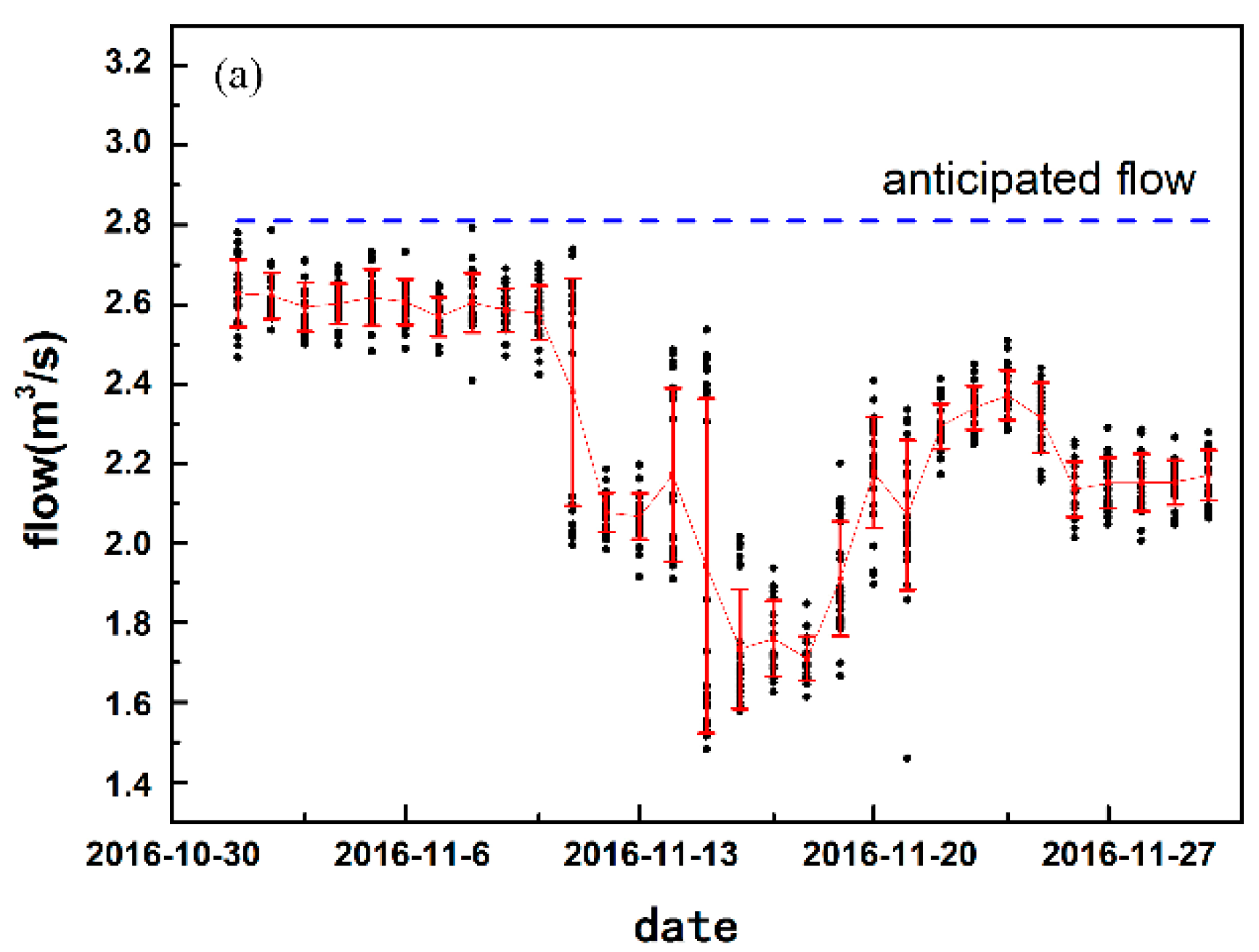
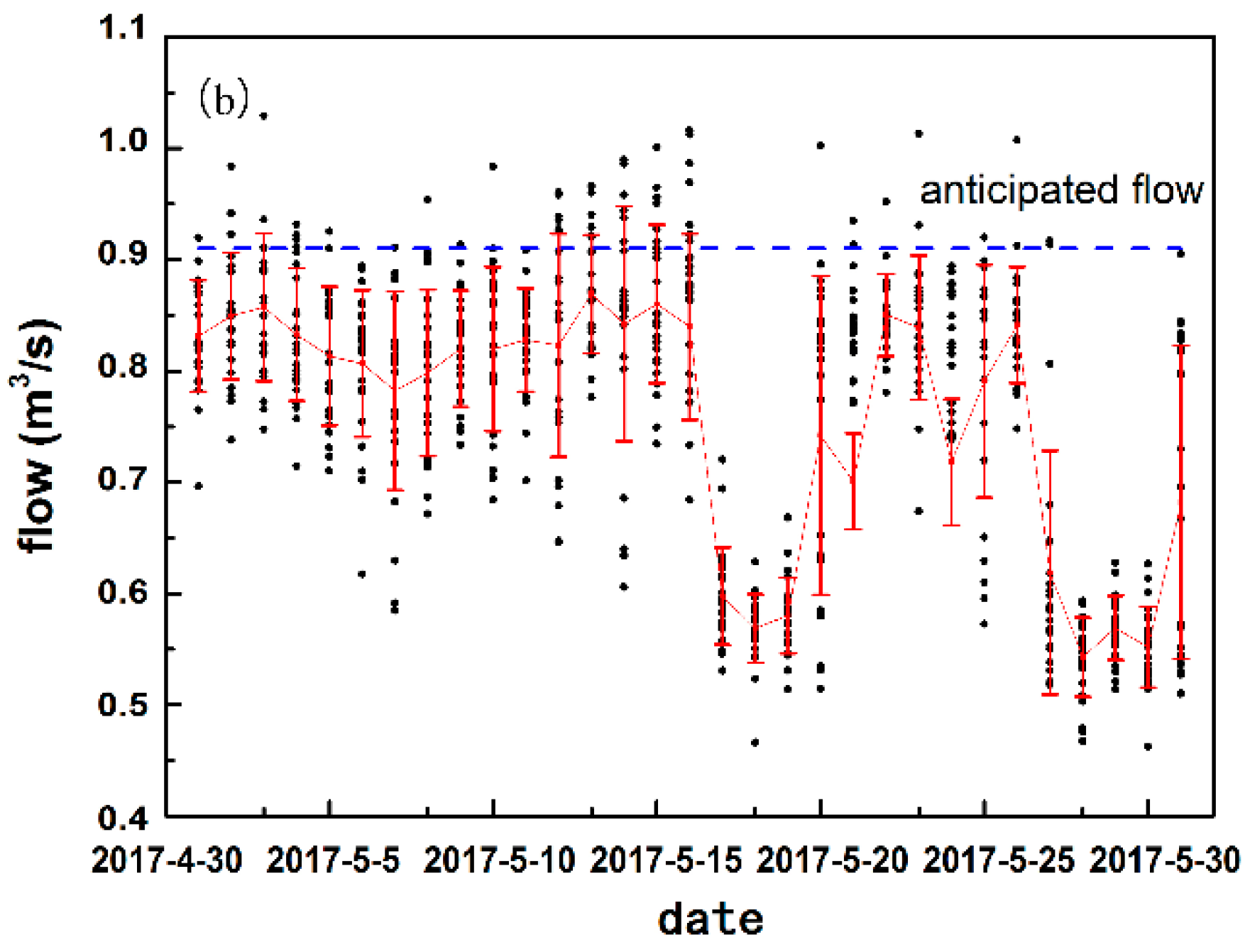



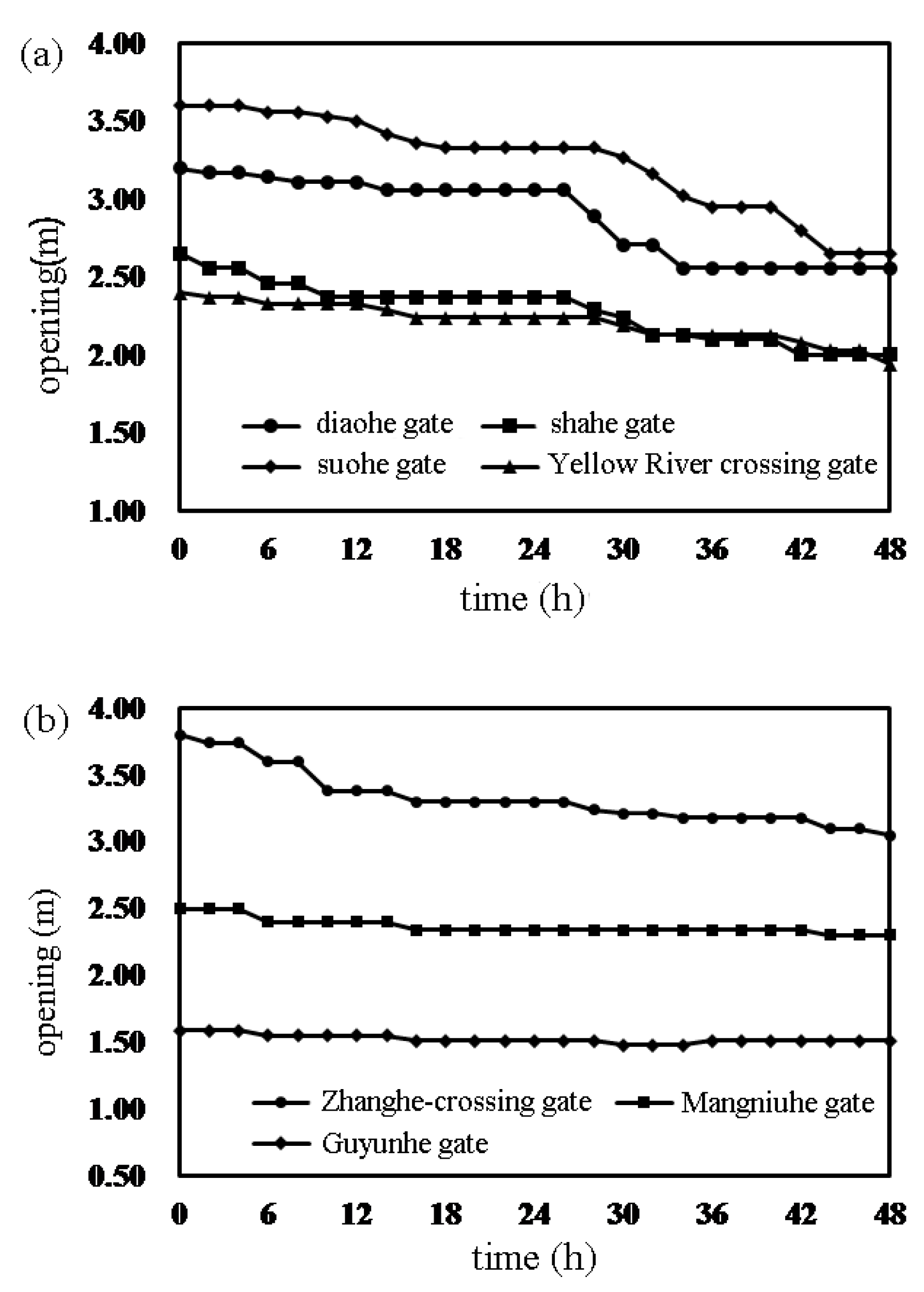
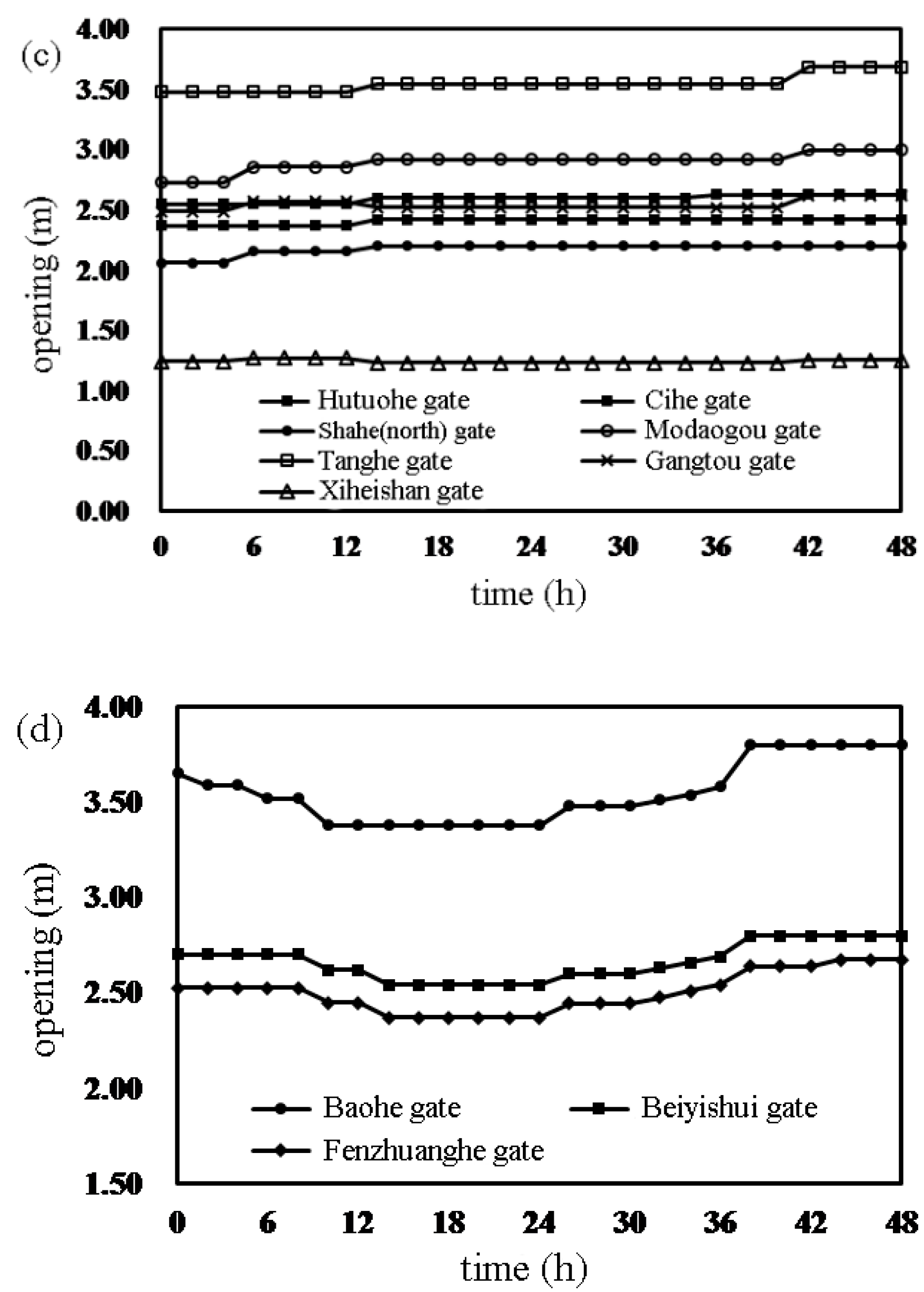
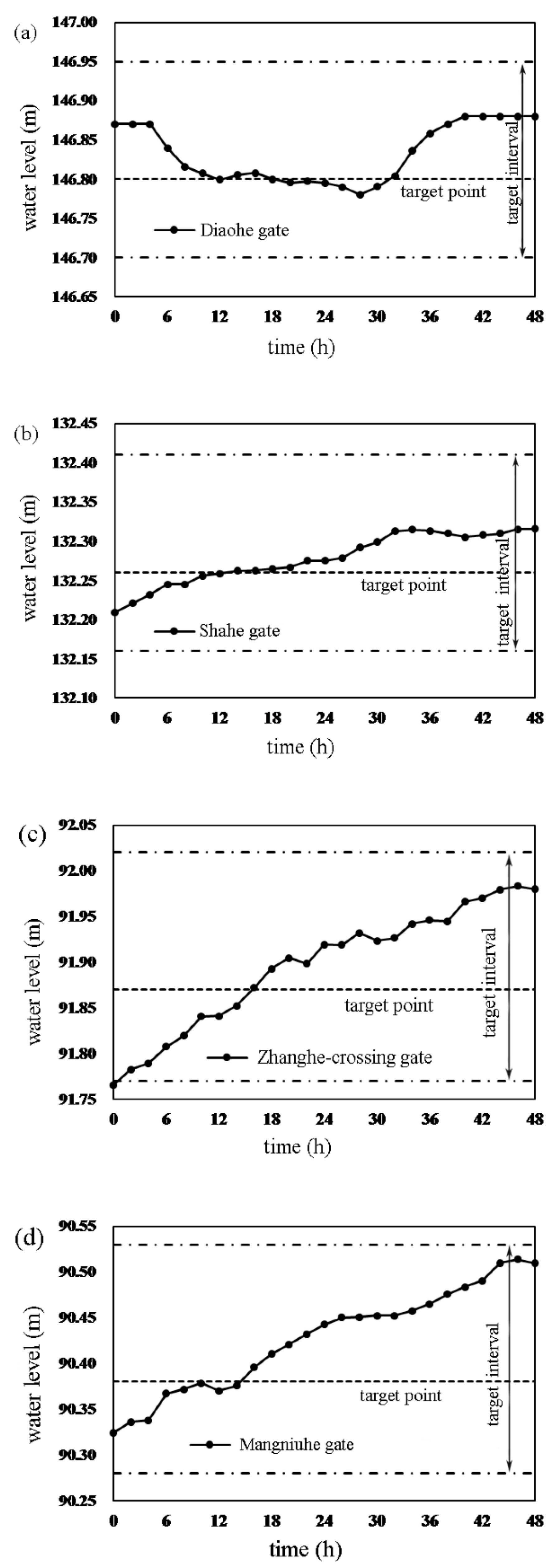
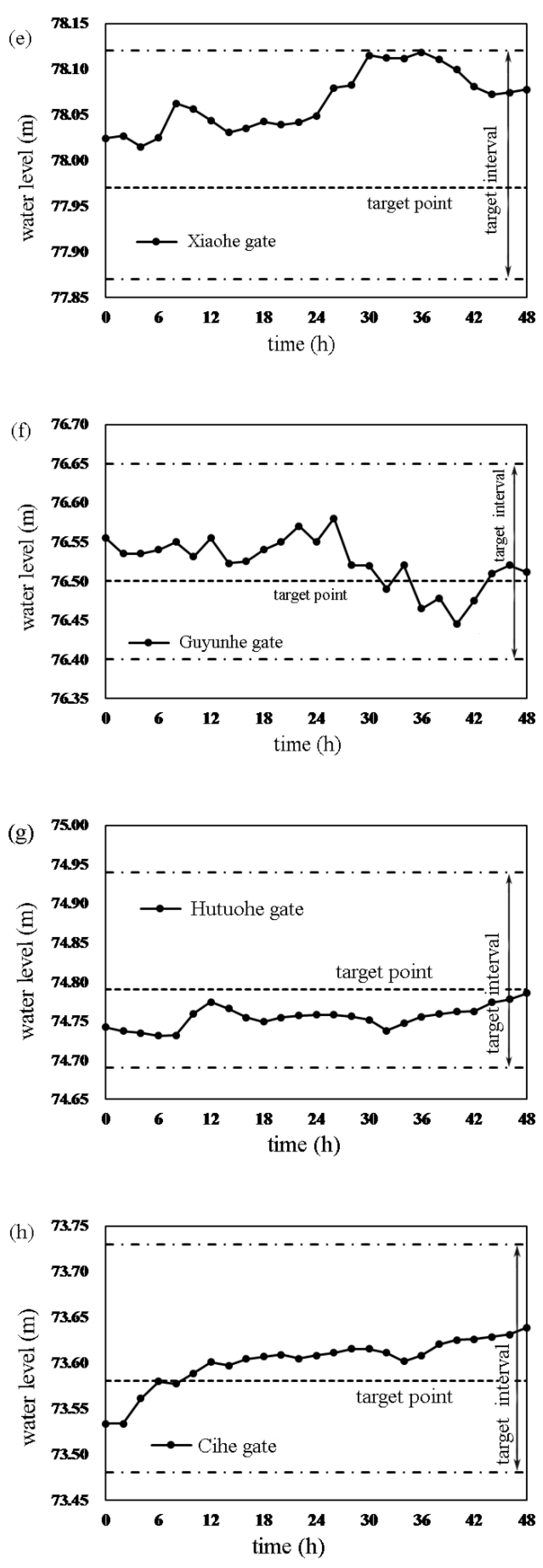
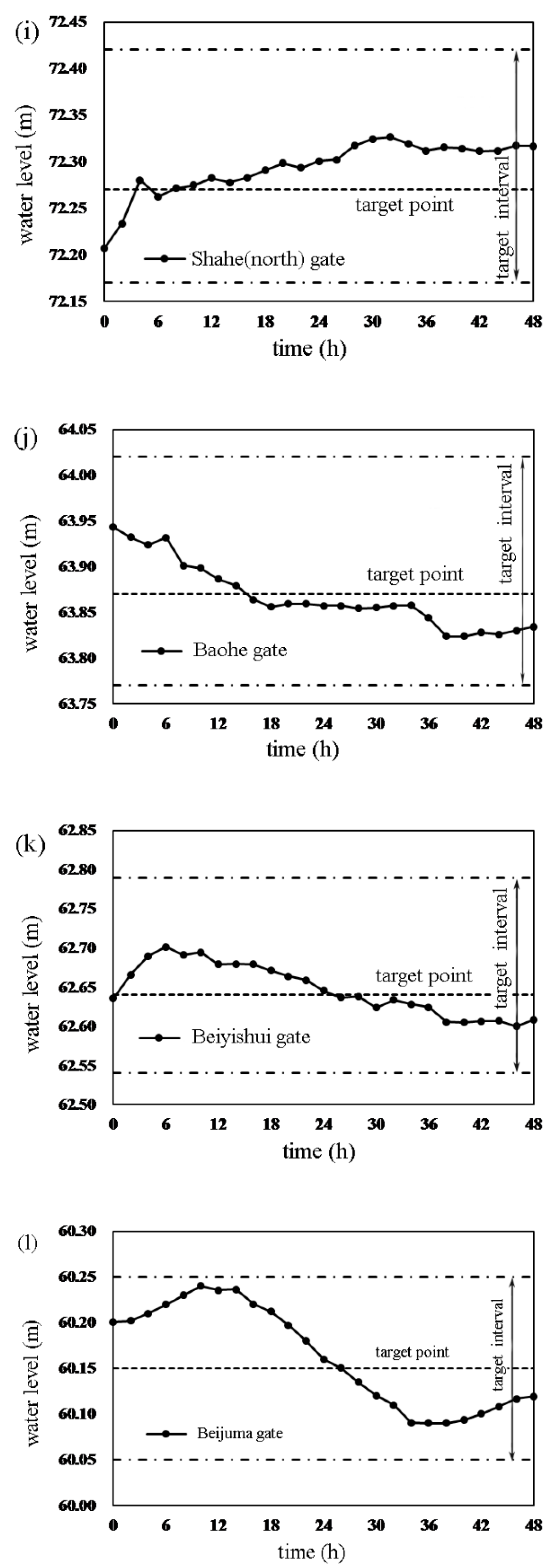
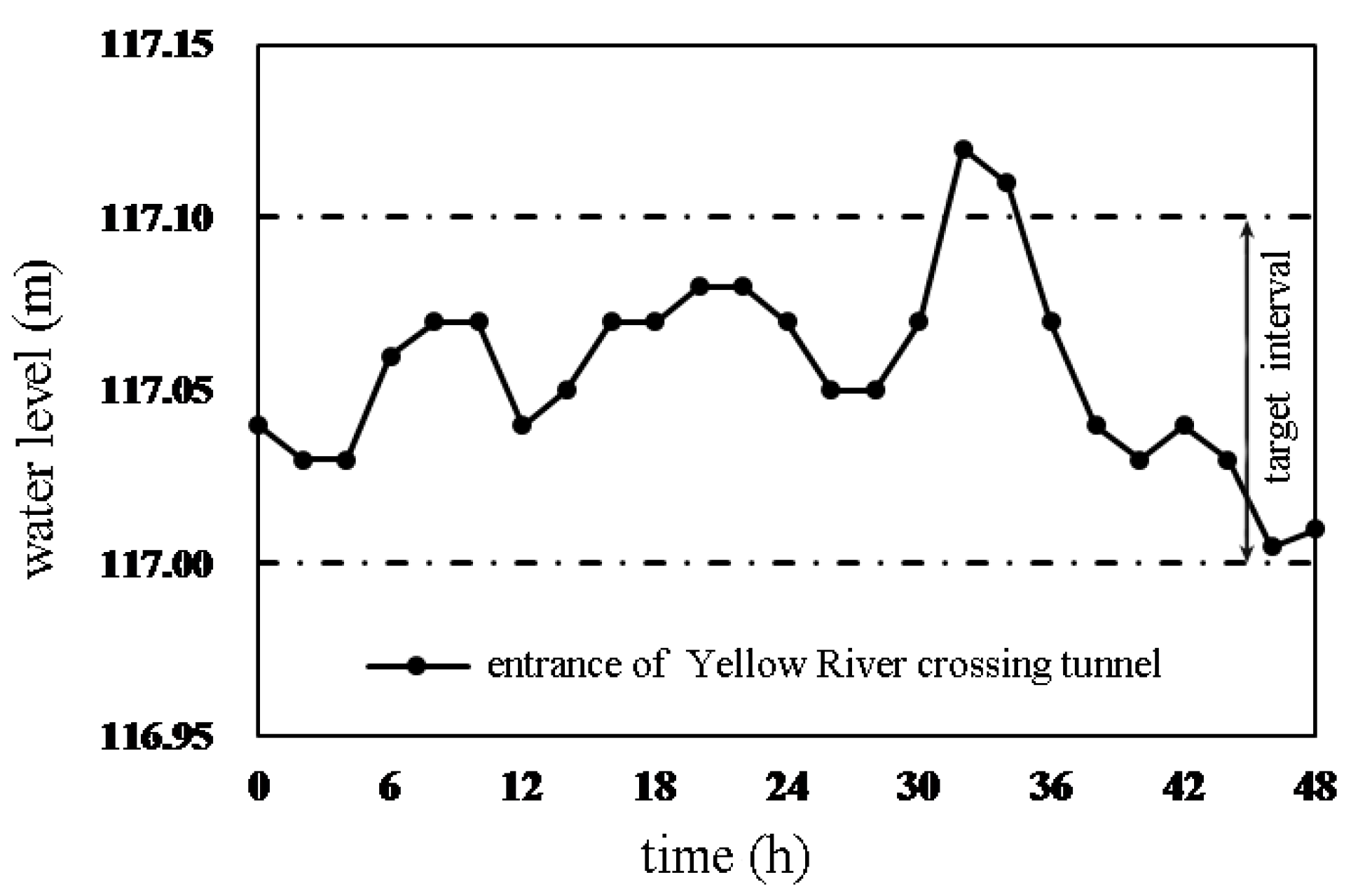
| Name of Diversion | Initial Flow (m3/s) | Target Flow (m3/s) | Flow Change (m3/s) | Requirement |
|---|---|---|---|---|
| Fuyanghe diversion | 6 | 3 | −3 | 12 h later |
| Hutuohe diversion | 10 | 5 | −5 | 12 h later |
| Shahe (north) diversion | 10 | 0 | −10 | the initial time |
| Tanghe diversion | 0 | 3 | 3 | the initial time |
| Baohe diversion | 3 | 10 | 7 | the initial time |
| Beiyishui diversion | 5 | 2 | −3 | the initial time |
| Gate Number | Name of Check Gate | Water Level Upstream of Check Gate (m) | Openings (m) | Flow (m3/s) | Target Water Level (m) | Initial Water Level Deviation (m) |
|---|---|---|---|---|---|---|
| 1 | Diaohe | 146.87 | 0.320/0.320 | 242.46 | 146.80 | 0.07 |
| 2 | Tuanhe | 145.76 | 0.335/0.335/0.335 | 232.77 | 145.65 | 0.11 |
| 3 | Yanlinghe | 144.81 | 0.280/0.280 | 144.74 | 144.74 | 0.07 |
| 4 | Qihe (Nanyang) | 143.25 | 0.269/0.269/0.269/0.269 | 233.57 | 143.17 | 0.08 |
| 5 | Shi’erlihe | 141.93 | 0.249/0.249 | 235.80 | 141.93 | 0.00 |
| 6 | Baihe | 140.20 | 0.480/0.480/0.480/0.480 | 236.56 | 140.20 | 0.00 |
| 7 | Dongzhao | 139.44 | 0.266/0.260/0.260/0.266 | 235.07 | 139.45 | −0.01 |
| 8 | Huangjinhe | 137.97 | 0.330/0.330/0.330/0.330 | 229.74 | 137.97 | 0.00 |
| 9 | Caodunhe | 136.70 | 0.206/0.206 | 234.83 | 136.70 | 0.00 |
| 10 | Lihe | 134.54 | 0.390/0.390 | 229.93 | 134.60 | −0.06 |
| 11 | Penghe | 133.15 | 0.330/0.330 | 224.76 | 133.06 | 0.09 |
| 12 | Shahe | 132.21 | 0.265/0.265/0.265/0.265 | 225.31 | 132.26 | −0.05 |
| 13 | Yudaihe | 129.78 | 0.220/0.220/0.220/0.220 | 223.02 | 129.71 | 0.07 |
| 14 | Beiruhe | 128.11 | 0.358/0.358/0.358/0.358 | 226.99 | 128.16 | −0.05 |
| 15 | Lanhe | 127.17 | 0.400/0.400 | 229.47 | 127.27 | −0.10 |
| 16 | Yinghe | 125.92 | 0.288/0.288/0.288/0.288 | 223.76 | 125.91 | 0.01 |
| 17 | Xiaohonghe | 124.75 | 0.278/0.278/0.278/0.278 | 219.11 | 124.76 | −0.01 |
| 18 | Shuangjihe | 123.53 | 0.420/0.420/0.420/0.420 | 220.56 | 123.52 | 0.01 |
| 19 | Meihe | 122.58 | 0.285/0.285/0.285/0.285 | 225.04 | 122.52 | 0.06 |
| 20 | Zhangbagou | 121.71 | 0.420/0.420/0.420/0.420 | 224.39 | 121.76 | −0.05 |
| 21 | Chaohe | 120.98 | 0.345/0.345/0.345/0.345 | 217.43 | 121.01 | −0.03 |
| 22 | Jinshuihe | 120.02 | 0.310/0.310/0.310/0.310 | 201.46 | 119.99 | 0.03 |
| 23 | Xushuihe | 119.36 | 0.500/0.500/0.500/0.500 | 199.39 | 119.37 | −0.01 |
| 24 | Suohe | 118.68 | 0.360/0.360 | 202.04 | 118.72 | −0.04 |
| 25 | Yellow River crossing | 113.80 | 0.240/0.240 | 202.69 | - | - |
| 26 | Jihe | 107.54 | 0.224/0.224/0.224/0.224 | 209.17 | 107.60 | −0.06 |
| 27 | Yanhe | 105.28 | 0.219/0.219/0.219/0.219 | 209.25 | 105.15 | 0.13 |
| 28 | Kuichengzhai | 103.59 | 0.290/0.285/0.285/0.290 | 204.22 | 103.54 | 0.05 |
| 29 | Yuhe | 102.89 | 0.207/0.207/0.207 | 202.00 | 102.82 | 0.07 |
| 30 | Huangshuihezhi | 100.30 | 0.380/0.380/0.380/0.380 | 204.31 | 100.24 | 0.06 |
| 31 | Mengfenhe | 99.18 | 0.237/0.237/0.237/0.237 | 197.76 | 99.14 | 0.04 |
| 32 | Xiangquanhe | 97.80 | 0.440/0.212/0.212 | 196.69 | 97.73 | 0.07 |
| 33 | Qihe | 95.83 | 0.276/0.276/0.276 | 201.02 | 95.79 | 0.04 |
| 34 | Tanghe | 94.66 | 0.263/0.263 | 191.33 | 94.60 | 0.06 |
| 35 | Anyanghe | 92.65 | 0.365/0.365/0.365 | 190.77 | 92.77 | −0.12 |
| 36 | Zhanghe-crossing | 91.77 | 0.380/0.380/0.380 | 185.61 | 91.87 | −0.10 |
| 37 | Mangniuhe | 90.32 | 0.250/0.250/0.250 | 177.69 | 90.38 | −0.06 |
| 38 | Qinhe | 88.89 | 0.330/0.330/0.330 | 168.53 | 88.93 | −0.04 |
| 39 | Minghe | 87.80 | 0.227/0.227/0.227 | 171.86 | 87.91 | −0.11 |
| 40 | Nanshahe | 86.03 | 0.241/0.241/0.241 | 175.88 | 85.91 | 0.12 |
| 41 | Qilihe | 84.79 | 0.310/0.310/0.310 | 171.96 | 84.92 | −0.13 |
| 42 | Baimahe | 83.88 | 0.267/0.267/0.267 | 168.76 | 83.95 | −0.07 |
| 43 | Liyanghe | 82.54 | 0.278/0.278/0.278 | 164.48 | 82.66 | −0.12 |
| 44 | Wuhe | 80.96 | 0.200/0.200/0.200 | 158.89 | 81.03 | −0.07 |
| 45 | Huaihe | 79.37 | 0.260/0.260/0.260 | 163.37 | 79.51 | −0.14 |
| 46 | Xiaohe | 78.02 | 0.224/0.23/0.224 | 157.83 | 77.97 | 0.05 |
| 47 | Guyunhe | 76.56 | 0.161/0.155/0.161 | 147.52 | 76.40 | 0.16 |
| 48 | Hutuohe | 74.74 | 0.255/0.255/0.255 | 129.19 | 74.79 | −0.05 |
| 49 | Cihe | 73.53 | 0.237/0.237/0.237 | 114.61 | 73.58 | −0.05 |
| 50 | Shahe (north) | 72.21 | 0.206/0.206/0.206 | 107.85 | 72.27 | −0.06 |
| 51 | Modaogou | 70.94 | 0.273/0.273/0.273 | 104.59 | 71.02 | −0.08 |
| 52 | Tanghe | 70.15 | 0.346/0.349/0.349 | 103.34 | 70.19 | −0.04 |
| 53 | Fangshuihe | 68.94 | 0.200/0.200/0.200 | 109.75 | 68.90 | 0.04 |
| 54 | Puyanghe | 68.05 | 0.363/0.363/0.363 | 105.48 | 68.00 | 0.05 |
| 55 | Gangtou | 65.76 | 0.249/0.249 | 103.29 | 65.69 | 0.07 |
| 56 | Xiheishan | 65.09 | 0.123/0.127/0.123 | 56.54 | 65.08 | 0.01 |
| 57 | Baohe | 63.94 | 0.365/0.365 | 52.96 | 63.87 | 0.07 |
| 58 | Beiyishui | 62.64 | 0.270/0.270 | 50.87 | 62.64 | 0.00 |
| 59 | Fenzhuanghe | 61.77 | 0.250/0.255 | 50.41 | 61.80 | −0.03 |
| 60 | Beijuma | 60.20 | 0.405/0.405 | 47.03 | 60.15 | 0.05 |
| Name of Check Gates | Number of the Times of Gate Adjustments | Name of Check Gates | Number of the Times of Gate Adjustment | ||
|---|---|---|---|---|---|
| Proposed Model | Traditional PID Model | Proposed Model | Traditional PID Model | ||
| Diaohe | 7 | 12 | Shahe (north) | 2 | 4 |
| Shahe | 8 | 12 | Muodaogou | 3 | 6 |
| Suohe | 10 | 15 | Tanghe | 2 | 7 |
| Yellow River Crossing | 7 | 18 | Gangtou | 3 | 6 |
| Zhanghe-Crossing | 4 | 15 | Xiheisha | 2 | 7 |
| Mangniuhe | 3 | 15 | Baohe | 8 | 15 |
| Guyunhe | 4 | 8 | Beiyishui | 8 | 16 |
| Hutuohe | 1 | 4 | Fenzhuanghe | 9 | 16 |
| Cihe | 1 | 4 | |||
Publisher’s Note: MDPI stays neutral with regard to jurisdictional claims in published maps and institutional affiliations. |
© 2020 by the authors. Licensee MDPI, Basel, Switzerland. This article is an open access article distributed under the terms and conditions of the Creative Commons Attribution (CC BY) license (http://creativecommons.org/licenses/by/4.0/).
Share and Cite
Wu, Y.; Li, L.; Liu, Z.; Chen, X.; Huang, H. Real-Time Control of the Middle Route of South-to-North Water Diversion Project. Water 2021, 13, 97. https://doi.org/10.3390/w13010097
Wu Y, Li L, Liu Z, Chen X, Huang H. Real-Time Control of the Middle Route of South-to-North Water Diversion Project. Water. 2021; 13(1):97. https://doi.org/10.3390/w13010097
Chicago/Turabian StyleWu, Yongyan, Liqun Li, Zihui Liu, Xiaonan Chen, and Huiyong Huang. 2021. "Real-Time Control of the Middle Route of South-to-North Water Diversion Project" Water 13, no. 1: 97. https://doi.org/10.3390/w13010097
APA StyleWu, Y., Li, L., Liu, Z., Chen, X., & Huang, H. (2021). Real-Time Control of the Middle Route of South-to-North Water Diversion Project. Water, 13(1), 97. https://doi.org/10.3390/w13010097




